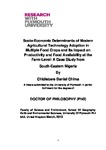Socio-Economic Determinants of Modern Agricultural Technology Adoption in Multiple Food Crops and Its Impact on Productivity and Food Availability at the Farm-Level: A Case Study from South-Eastern Nigeria
| dc.contributor.supervisor | Rahman, Sanzidur | |
| dc.contributor.author | Chima, Chidiebere Daniel | |
| dc.contributor.other | School Of Geography, Earth and Environmental Sciences | en_US |
| dc.date.accessioned | 2015-04-21T13:16:15Z | |
| dc.date.available | 2015-04-21T13:16:15Z | |
| dc.date.issued | 2015 | |
| dc.identifier | 256303 | en_US |
| dc.identifier.uri | http://hdl.handle.net/10026.1/3310 | |
| dc.description.abstract |
Farmers generally produce multiple crops while selectively adopting modern technologies to meet various needs. The main aim of this study is, therefore, to identify the range of socio-economic factors influencing the adoption of modern agricultural technology in multiple food crops and the corresponding impacts on productivity and food availability at the farm-level in South-eastern Nigeria. In this study, three major food crops (i.e., rice, yam and cassava) and two elements of modern technologies (i.e., HYV seeds and inorganic fertilizers) are considered. The hypotheses of the study are that inverse farm size – technology adoption, size – productivity, size- profitability and size – food availability relationships exist in Nigerian agriculture. The research is based on an in-depth farm-survey of 400 farmers from two states (251 from Ebonyi and 149 from Anambra states) of South-eastern Nigeria. Data has also been derived from surveys and interviews of ADP Program Managers and NGOs. A range of qualitative and quantitative methods including inferential statistics, bivariate probit model and regression analysis were used in order to achieve the specific objectives and test hypotheses. The results show that sample respondents are dominated by small scale farmers (81% of total) owning land less than 1 ha. The average farm size is small estimated at 1.27 ha. Farmers grow multiple crops instead of a single crop, i.e., 68% of the surveyed farmers grew at least two food crops. The level of modern technology adoption is low and mixed and farmers selectively adopt components of technologies as expected and use far less than recommended dose of fertilizers in crops. Only 29% of farmers adopted both HYV seeds and fertilizers as a package. The study clearly demonstrates that inverse farm size – technology adoption, farm size – productivity, and farm size – food availability relationships exist in agriculture in this region of Nigeria; but not inverse farm size – profitability. The bivariate probit model diagnostic reveals that the decision to adopt modern technologies are significantly correlated, implying that univariate analysis of such decisions are biased, thereby, justifying use of the bivariate approach. Overall, the most dominant determinants are the positive influence of farming experience and the negative influence of remoteness of extension services on modern technology adoption. The per capita per day level of mean food produced is 12322.74 calories from one ha of land and food available for consumption is 4693.34 calories which is higher than the daily requirement of 2000 calories. Yam is produced mainly for sale while cassava is produced for consumption. Regression analysis shows that farm size and share of cassava in the total crop portfolio significantly increases food availability. A host of constraints are affecting Nigerian agriculture, which includes lack of extension agents, credit facilities, farm inputs, irrigation, and value addition and corruption, lack of support for ADP staff and ineffective government policies. Policy implications include investment in extension credit services and other infrastructure (e.g., irrigation, ADP staff), training of small farmers in business skills, promotion of modern technology, as a package as well as special projects targeted for cassava (e.g., Cassava Plus project) in order to boost modern technology adoption in food crops, as well as improving productivity, profitability and food availability at the farm-level in Nigeria. | en_US |
| dc.language.iso | en | en_US |
| dc.publisher | Plymouth University | en_US |
| dc.subject | Food Availability | en_US |
| dc.subject | Agricultural Adoption | en_US |
| dc.subject | Modern Technology | en_US |
| dc.subject | Multiple Food Crop | en_US |
| dc.subject | Food Security | en_US |
| dc.subject | Socio-economic Determinants | en_US |
| dc.subject | Bivariate Probit | en_US |
| dc.subject | Agricultural Technology Adoption | en_US |
| dc.subject | Agricultural Constraints | en_US |
| dc.title | Socio-Economic Determinants of Modern Agricultural Technology Adoption in Multiple Food Crops and Its Impact on Productivity and Food Availability at the Farm-Level: A Case Study from South-Eastern Nigeria | en_US |
| dc.type | Thesis | |
| plymouth.version | Full version | en_US |
| dc.identifier.doi | http://dx.doi.org/10.24382/4370 |
Files in this item
This item appears in the following Collection(s)
-
01 Research Theses Main Collection
Research Theses Main


